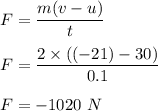
Physics, 30.03.2020 23:53 powellmj9216
A ball of mass 2.0 kg falls vertically downward. Just before hitting the floor its speed is 30 m/s. Just after rebounding upward its speed is 21 m/s. If this change in velocity took place in a time of 0.10 seconds, what is the average net force on the ball

Answers: 1
Another question on Physics

Physics, 21.06.2019 16:10
According to the phase diagram for water, how is the state of water determined? proceed up a vertical line at any given temperature read the phase at the intersection of any given temperature and pressure at a given pressure, proceed horizontally to the s-l or l-g line
Answers: 2

Physics, 21.06.2019 22:40
The desk has a weight of 75 lb and a center of gravity at g. determine the initial acceleration of a desk when the man applies enough force f to overcome the static friction at a and b. also, find the vertical reactions on each of the two legs at a and at b. the coefficients of static and kinetic friction at a and b are ms = 0.5 and mk = 0.2, respectively
Answers: 2

Physics, 22.06.2019 11:20
The ultracentrifuge is an important tool for separating and analyzing proteins. because of the enormous centripetal accelerations, the centrifuge must be carefully balanced, with each sample matched by a sample of identical mass on the opposite side. any difference in the masses of opposing samples creates a net force on the shaft of the rotor, potentially leading to a catastrophic failure of the apparatus. suppose a scientist makes a slight error in sample preparation and one sample has a mass 10 mg larger than the opposing sample. if the samples are 12 cm from the axis of the rotor and the ultracentrifuge spins at 70,000 rpm, what is the magnitude of the net force on the rotor due to the unbalanced samples? ( be thorough on your answer)
Answers: 3

Physics, 22.06.2019 20:40
Ablock of mass m = 2.5 kg is attached to a spring with spring constant k = 740 n/m. it is initially at rest on an inclined plane that is at an angle of theta= 26 with respect to the horizontal, and the coefficient of kinetic friction between the block and the plane is uk = 0.17. in the initial position, where the spring is compressed by a distance of d = 0.16 m, the mass is at its lowest position and the spring is compressed the maximum amount. take the initial gravitational energy of the block as zero. the block's initial mechanical energy is 9.472 j.b. if the spring pushes the block up the incline, what distance l in meters will the block travel before coming to rest? the spring remains attached to both the block and the fixed wall throughout its motion.
Answers: 3
You know the right answer?
A ball of mass 2.0 kg falls vertically downward. Just before hitting the floor its speed is 30 m/s....
Questions


Physics, 22.09.2019 23:50

Mathematics, 22.09.2019 23:50

Social Studies, 22.09.2019 23:50


Mathematics, 22.09.2019 23:50



Mathematics, 22.09.2019 23:50

Computers and Technology, 22.09.2019 23:50

Mathematics, 22.09.2019 23:50

Social Studies, 22.09.2019 23:50


Geography, 22.09.2019 23:50

Mathematics, 22.09.2019 23:50

Mathematics, 22.09.2019 23:50


Arts, 22.09.2019 23:50

Mathematics, 22.09.2019 23:50





